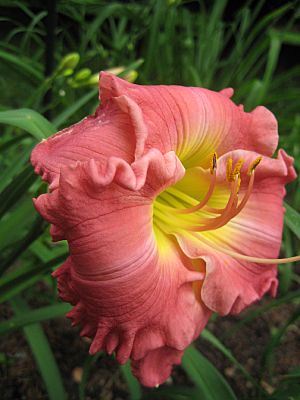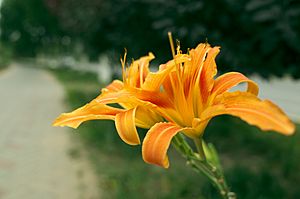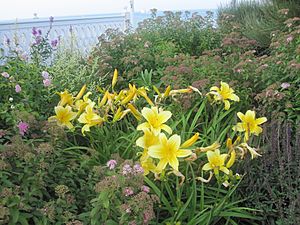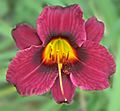Daylily facts for kids
Quick facts for kids Daylily |
|
|---|---|
 |
|
| Hemerocallis 'Hush Little Baby' | |
| Scientific classification | |
| Kingdom: |
Plantae
|
| Division: | |
| Class: | |
| Order: | |
| Family: |
Ashphodelaceae
|
| Subfamily: |
Hemerocallidoideae
|
| Genus: |
Hemerocallis
|
The Daylily is a beautiful flower known by its scientific name, Hemerocallis. These flowers come in many different colors and shapes. Gardeners love them because they are easy to grow. They can also be changed easily to create new types.
The name Hemerocallis comes from ancient Greek words. "Hēmera" means "day," and "kalos" means "beautiful." This name suggests that the flowers usually bloom for only one day. An example is the Hemerocallis fulva, also called the ditch lily.
Some daylily flowers can even be eaten! They are used in Chinese cooking. You might find them in Asian markets. They are sold as "gum jum" or "golden needles." In Chinese, this is "jīnzhēn." They are also called "yellow flower vegetables" or "huánghuācài."
Contents
What are Daylilies?

Daylilies are perennial plants. This means they live for more than two years. Each flower usually lasts only about 24 hours. Most daylily flowers open in the morning. They then close by the next night. A new flower might open on the same stem the next day. Some types of daylilies even bloom at night.
Daylilies are not often used in fancy flower arrangements. But they still make good cut flowers. New flowers will keep opening on the cut stems for several days.
Where Do Daylilies Come From?
Hemerocallis plants are originally from Asia. They mostly come from eastern Asia. This includes countries like China, Korea, and Japan. Daylilies are popular all over the world. People love their colorful flowers. Many types are also very tough and easy to grow.
There are over 80,000 different types of daylilies. These are called cultivars. Many cultivars have flowers that smell nice. More new scented types are being created by plant breeders. Some early blooming types will bloom again later in the year. This often happens if their seed pods are removed.
Parts of a Daylily Plant
Most daylilies grow in clumps. Each clump has leaves, a crown, flowers, and roots. The leaves are long and thin. They grow in groups like a fan. The crown is a small white part. It is found between the leaves and the roots.
Small leafy "plantlets" can grow on the flower stalk, called a scape. These plantlets are called "proliferations." If you plant a proliferation, it will grow roots. It will become an exact copy of the parent plant. Many daylilies have thick roots. These roots store food and water for the plant.
How a Daylily Flower Looks
A normal daylily flower has three petals and three sepals. These are together called tepals. Each tepal has a line down the middle. This line can be the same color as the rest of the flower. Or it can be a different color.
The very center of the flower is called the throat. It is usually a different color from the outer parts of the tepals. Each flower usually has six stamens. Each stamen has a two-lobed anther. After a flower is pollinated, it forms a seed capsule.
Daylilies That Spread Easily
The Tawny or Fulvous Daylily (Hemerocallis fulva) can spread very quickly. In some parts of the United States, it is considered an invasive plant. This means it can take over areas.
Some people plant the Fulvous Daylily and other types that have underground runners. These types can quickly fill up a garden. It can take a lot of work to keep them in check or remove them.
Images for kids
-
The tawny daylily (Hemerocallis fulva)
See also
 In Spanish: Hemerocallis para niños
In Spanish: Hemerocallis para niños











